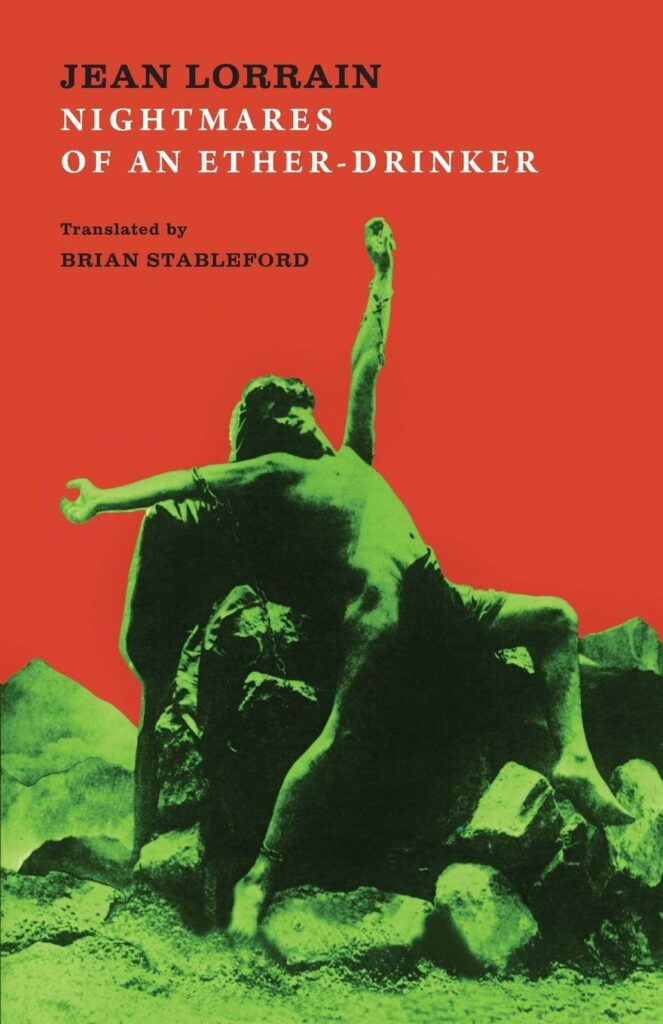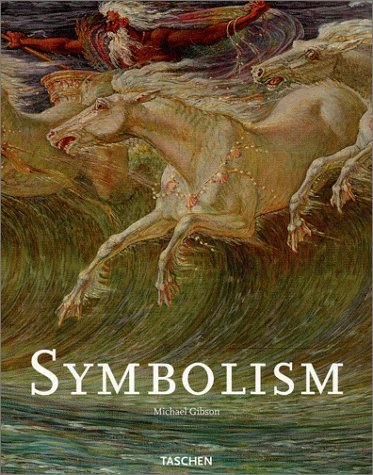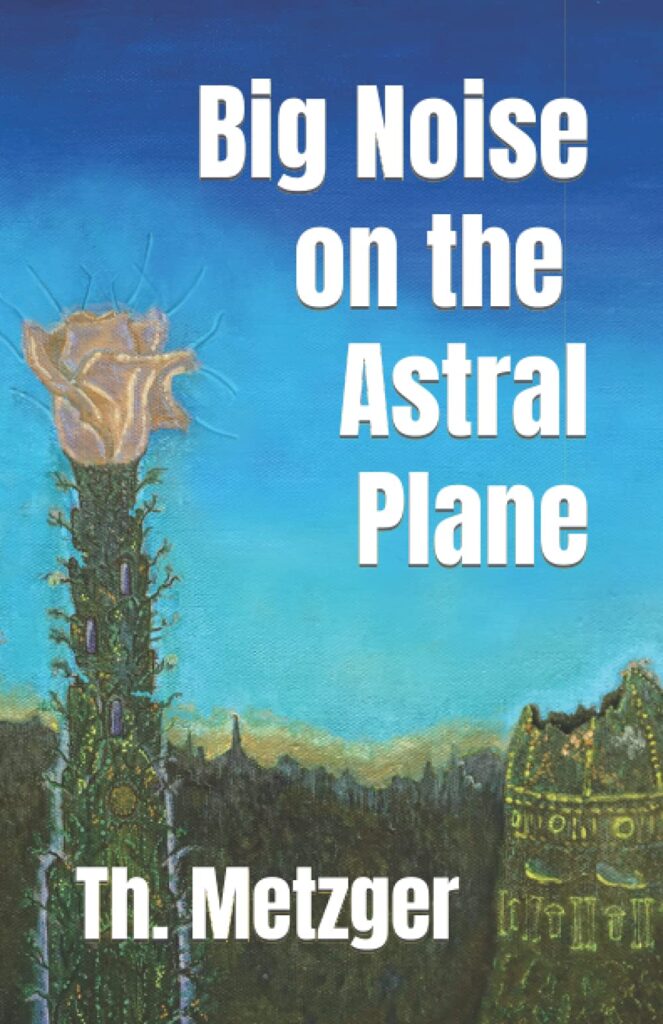Nightmares of an Ether Drinker was the most enthralling book to cross our desk in months and months. The translator, Brian Stableford, a venerated elder of the SF community, begat some fifty novels in the course of the twentieth century. Since the year 2000 he has translated French decadent books at the rate of nearly three a year, published by the disarmingly named Snuggly Books.
I haven’t seen Stableford’s novels, which is something of a feat considering their cornucopic quantity, but I wasn’t hopeful as I pondered the stats on his French translations. I feared that Google Translate was the unsung hero of such relentless output.
This was not at all the case. Despite the occasional trivial error attendant upon haste, the translations are all reasonably good. But Jean Lorrain himself is a real discovery.
I never read him in French. He is one of those writers who really enjoys using rare exotic words and slangy expressions to liven up his paragraphs. Not pretentiously or gratuitously—it’s the side effect of a too-great love of language. Huysmans is much the same—you read him dictionary in hand, even if your French is good enough for Balzac.
Jean Lorrain was in some ways the French equivalent of Oscar Wilde, the poster boy for Decadence. Like Wilde, he was a great tall robust fellow. Not some delicate, easily bruised little fruit. More like a pineapple.
In tolerant France, Lorrain was able to live as more or less openly gay, and publish literary and lurid tales of drugs and perversion. He was equally at home in high society and among low company—he had a very pronounced taste for rough trade and hard drugs, and little interest in keeping his interests compartmentalized.
Called upon to explain himself on this head, Lorrain remarked, “What can I tell you, I like things that are real, intense, startling, things that don’t bore me, like you lot.”
I first heard of Lorrain in the pages of Philippe Julian’s Dreamers of Decadence, the most literary and interesting of the many surveys of Symbolist and Decadent art. Julian, who committed suicide after his lover died, wrote a biography of Jean Lorrain (never translated into English) which would be well worth bringing out.
Not everyone liked Lorrain. He was a literary society journalist who wrote, like Poe, “with a pen dipped in vitriol.” He was challenged to duels by a great number of eminent persons, including Guy de Maupassant and Marcel Proust. He had friends and admirers, but not everyone was delighted by his dandyism militant and taste for the outrageous. But as a rule, it was people who had achieved eminence or celebrity, like Robert de Montesquieu or Sarah Bernhardt, who kept him at arm’s length. He was a social liability, easier to admire than to be seen with.
But to the book. I’ve never seen anything quite like this fiction genre. The stories are all in the form of anecdotes, such as one might hear from a great raconteur. They don’t have a real plot structure and the characters aren’t developed in any depth. The ordering principle is the appalling or amusing or scary disclosure in the final paragraph. These are stories for after dinner when the cognac is making the rounds; designed to hold the room spellbound and end in general amazement.
The focus of these tales are variously drugs, weird sex, occult phenomena, or eviscerating insults. Lorrain is spectacularly snide, but is also compellingly poetic. He wrote several books of verse that are really quite good, and he overcomes our sense of what is probable or possible by sheer literary force. As with Poe, the writing is often out and out beautiful: the occult or psychedelic effects are sustained by high verbal art.
At the heart of the book is, of course, sex. In these stories, Lorrain uses vampirism as a metaphor for gay (“The Egregore”) and lesbian (“The Glass of Blood”) romance—in the latter case with particularly telling effect for the obvious subtextual reasons. Vampirism and similar occult conditions are a venerable coding of forbidden eros.
Ernest Jones’ unreadable but documentarily valuable On the Nightmare established that sexual symbolism was implicit in the witches, succubi, incubi, vampires, werewolves, &c. of traditional folklore. Mina’s “blood wedding” in Stoker’s Dracula is powerful through its subliminal suggestion of fellatio. The trope is excellently effective—until one reaches the time of Anne Rice and Twilight. Once the sex becomes explicit, it descends (as sex inevitably does at a certain point in its progress from fantasy to actuality) to the ridiculous. The coupling lycanthropes in today’s paranormal romances are laughable to anyone but Furries who, come to think of it, are probably these books’ target audience.
The apogee of horror in Lorrain, as one might expect from a gay author, is the description of women and their dark powers. The story “Beyond” describes how the scent of a woman’s essence can hurl a man from his bed and reverberate across a city with the power of parapsychology. It called to mind that great phrase from Pliny’s Natural History, “Thus we see the power of female secretions to be literally limitless.”
Another singularity is Lorrain’s interested in decor. The furnishings and appointments of the given haunted room or accursed mansion are described with the wittily detailed superiority of a gay interior decorator. The setting is always the key to the supernatural action, and sometimes is the supernatural action.
The book is a Fellini-like delirium, squealing with the souls of accidentally slain animals, writhing with ghoulish works of art that waken into uncanny life, unnatural acts glimpsed through hotel room keyholes in which carnival costumes and sex kaleidoscopically blur. It’s like the hallucinatory ball that ends Hesse’s Steppenwolf, but narrated by a French rake instead of a German bourgeois.
The heroes of these tales are bored, drug-dazed, poetic, aesthetic—like the cast for a music video to accompany T Rex’s “Dandy in the Underworld.” The locations are usually 1890’s Paris, and references to such contemporary demimonde luminaries as the artist Redon and the Rosicrucian impresario Peladan abound,—these Stableford has helpfully footnoted. There are also a number of tales set in coastal Normandy, where Lorrain grew up, and these are particularly rich in nostalgic beauty.
Nightmares of an Ether Drinker is something of a conundrum as regards its compilation. Stableford seems to have taken material from a number of collections without offering the reader any clue as to their provenance. This is then an anthology derived from from all periods of Lorrain’s prolific literary career, which explains the richness and variety of the material. It’s a magnificent book, and makes accessible to the Anglophone world the works of a decadent genius few here have heard of. A masterpiece to swoon over.
In the above review, I mentioned Philippe Julian’s Dreamers of Decadence, which remains the classic treatment of Symbolist and Decadent art, because of the author’s profound knowledge of the literature of these movements, and his personal engagement with it. This Taschen volume breaks new ground with a rich chapter on Symbolism in Poland and Russia, which Cold War politics kept out of range of Western art criticism. The characteristic high-quality binding and large clear reproductions of Taschen art books serve the subject well. There is also a chapter on the transition from Symbolist into Modern art, which is particularly revelatory. The usual art history timeline goes from the Impressionists and Fauves to Expressionism and Abstraction, pretty much omitting the Symbolists. Yet many of the key Modern figures, like Mondrian and Kandinsky, went through Symbolism en route to Abstraction, as this book demonstrates in striking and rarely reproduced images.The book is well written and deepens one’s understanding of this movement by showing its really impressive geographic extent and uncovering many masterpieces that have never been reproduced in such a survey. A valuable addition to any art library.
Thom Metzger’s most recent book, Big Noise on the Astral Plane, takes up where Undercover Mormon, the tale of his infiltration of the Mormon Church, left off. It’s a psychic travelogue across the “Burnt Over District” of upstate New York. This is a wide swathe of largely forgotten sites that hosted fervent and outré religious communities in the course of the nineteenth century. The Spiritist Fox Sisters of Rochester, The utopian Oneida Community, the Shakers, and many more.
The book is a first person narrative and, in the spirit of Kerouac’s novels, a quest for illumination and leadings across an American landscape which has no recollection of its own mythic implications. Metzger parts company with Kerouac on two important heads. He is entirely abstemious, while Kerouac depended on huge amounts of alcohol to fuel his mystical quests, and Metzger writes with the lucidity and narrative elegance of a professional writer of both fiction and nonfiction. Kerouac, of course, carries off the prize for poetic poignance and sentences that end antipodally far away from their start. But Metzger, be it noted, is no slouch when it comes to alliterative verbal frenzy and giddy swerves of plot.
The reason for juxtaposing Metzger and Kerouac is not to make facile lit-crit comparisons. Both authors were consciously creating a mythic landscape. Kerouac populating his with drug highs and his literary friends and Thom with his deranged friends and the shiniest, most lurid and lambent flashes of pop culture.
Both are performing an archetypal and humanly necessary action. Giving a sacred and meaningful dimension to the landscape of lived life. When the Bible identifies an asphaltic lake with the punishment of Sodom, when Micmac legend attributes the shape of a frog’s back to a squeeze from the god Glooscap, when the Greek traces the constellation Cancer to an arthropod that nipped the heel of the giant Orion, we see human beings giving spiritual, more-than-historical referents to the landscape they actually inhabit. People crave maps that take account of meaning—which have largely been obliterated by the mindset that gave us Google Earth.
Metzger is a kind of modern-day pagan, scrutinizing the world around him for traces of the numinous and finding these in rock and roll tunes (especially Elvis’), religious kitsch, and roadside dining, and the remaining traces of upstate New York’s historical identities. These range from the sites of vanished mystical movements to weirdly classical place names given in the misguided expectation that the New World would equal the old by such bare assertion.
The book relates Thom’s several years friendship with an unbalanced babbling acupuncturist who shares Thom’s sense that, somewhere deep in the infinite, Elvis and Egyptian Myth, Glam Rock and Sanskrit, Cairo, New York, and Cairo, Egypt, are one. The road trips Thom takes with the pin-bristling medical mystic Rudy Kilowatt are random and inconclusive, taking on their epic dimension through parallel narratives of Elvis mythology, Thom’s adolescent memories, and improvised hoodoo rituals that arise spontaneously to transform any ordinary business of life into a Dada event.
At several points in the book Thom compares his relation to Kilowatt to that of Ishmael to Ahab and Queequeg. The analogy is truer than might appear. As in Moby Dick, this tale weaves together at least three parallel narratives: adventure story, metaphysical drama, and personal memoir. They don’t always line up as neatly as one might hope, but when they do, it’s like the moment when Ahab grabs the intersection of three crossed harpoons and charges the whole deluded crew with his own mad energy.
Though it is hard for the reader to say exactly where he has arrived when at the end of this “Nantucket Sleigh-ride,” careening over highways and history to the relentless rock and roll riffs that inspire this devil-whale hunt of a book, it is a true modern spiritual adventure story, and would not be out of place on the shelf between Kerouac and Melville.


